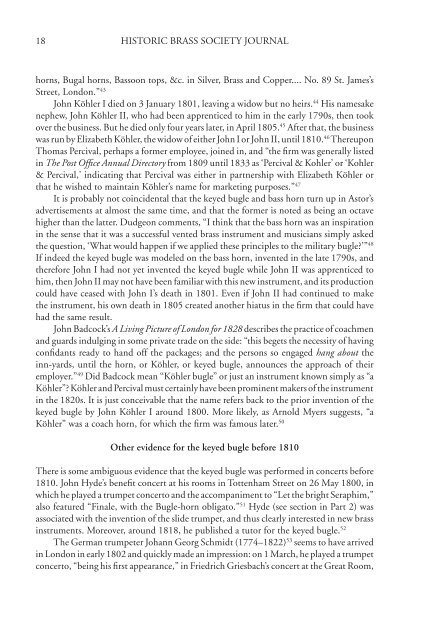New Light on the Early History of the Keyed Bugle Part I: The Astor ...
New Light on the Early History of the Keyed Bugle Part I: The Astor ...
New Light on the Early History of the Keyed Bugle Part I: The Astor ...
Create successful ePaper yourself
Turn your PDF publications into a flip-book with our unique Google optimized e-Paper software.
18<br />
HISTORIC BRASS SOCIETY JOURNAL<br />
horns, Bugal horns, Basso<strong>on</strong> tops, &c. in Silver, Brass and Copper.... No. 89 St. James’s<br />
Street, L<strong>on</strong>d<strong>on</strong>.” 43<br />
John Köhler I died <strong>on</strong> 3 January 1801, leaving a widow but no heirs. 44 His namesake<br />
nephew, John Köhler II, who had been apprenticed to him in <strong>the</strong> early 1790s, <strong>the</strong>n took<br />
over <strong>the</strong> business. But he died <strong>on</strong>ly four years later, in April 1805. 45 After that, <strong>the</strong> business<br />
was run by Elizabeth Köhler, <strong>the</strong> widow <strong>of</strong> ei<strong>the</strong>r John I or John II, until 1810. 46 <strong>The</strong>reup<strong>on</strong><br />
Thomas Percival, perhaps a former employee, joined in, and “<strong>the</strong> firm was generally listed<br />
in <strong>The</strong> Post Office Annual Directory from 1809 until 1833 as ‘Percival & Kohler’ or ‘Kohler<br />
& Percival,’ indicating that Percival was ei<strong>the</strong>r in partnership with Elizabeth Köhler or<br />
that he wished to maintain Köhler’s name for marketing purposes.” 47<br />
It is probably not coincidental that <strong>the</strong> keyed bugle and bass horn turn up in <strong>Astor</strong>’s<br />
advertisements at almost <strong>the</strong> same time, and that <strong>the</strong> former is noted as being an octave<br />
higher than <strong>the</strong> latter. Dudge<strong>on</strong> comments, “I think that <strong>the</strong> bass horn was an inspirati<strong>on</strong><br />
in <strong>the</strong> sense that it was a successful vented brass instrument and musicians simply asked<br />
<strong>the</strong> questi<strong>on</strong>, ‘What would happen if we applied <strong>the</strong>se principles to <strong>the</strong> military bugle?’” 48<br />
If indeed <strong>the</strong> keyed bugle was modeled <strong>on</strong> <strong>the</strong> bass horn, invented in <strong>the</strong> late 1790s, and<br />
<strong>the</strong>refore John I had not yet invented <strong>the</strong> keyed bugle while John II was apprenticed to<br />
him, <strong>the</strong>n John II may not have been familiar with this new instrument, and its producti<strong>on</strong><br />
could have ceased with John I’s death in 1801. Even if John II had c<strong>on</strong>tinued to make<br />
<strong>the</strong> instrument, his own death in 1805 created ano<strong>the</strong>r hiatus in <strong>the</strong> firm that could have<br />
had <strong>the</strong> same result.<br />
John Badcock’s A Living Picture <strong>of</strong> L<strong>on</strong>d<strong>on</strong> for 1828 describes <strong>the</strong> practice <strong>of</strong> coachmen<br />
and guards indulging in some private trade <strong>on</strong> <strong>the</strong> side: “this begets <strong>the</strong> necessity <strong>of</strong> having<br />
c<strong>on</strong>fidants ready to hand <strong>of</strong>f <strong>the</strong> packages; and <strong>the</strong> pers<strong>on</strong>s so engaged hang about <strong>the</strong><br />
inn-yards, until <strong>the</strong> horn, or Köhler, or keyed bugle, announces <strong>the</strong> approach <strong>of</strong> <strong>the</strong>ir<br />
employer.” 49 Did Badcock mean “Köhler bugle” or just an instrument known simply as “a<br />
Köhler”? Köhler and Percival must certainly have been prominent makers <strong>of</strong> <strong>the</strong> instrument<br />
in <strong>the</strong> 1820s. It is just c<strong>on</strong>ceivable that <strong>the</strong> name refers back to <strong>the</strong> prior inventi<strong>on</strong> <strong>of</strong> <strong>the</strong><br />
keyed bugle by John Köhler I around 1800. More likely, as Arnold Myers suggests, “a<br />
Köhler” was a coach horn, for which <strong>the</strong> firm was famous later. 50<br />
O<strong>the</strong>r evidence for <strong>the</strong> keyed bugle before 1810<br />
<strong>The</strong>re is some ambiguous evidence that <strong>the</strong> keyed bugle was performed in c<strong>on</strong>certs before<br />
1810. John Hyde’s benefit c<strong>on</strong>cert at his rooms in Tottenham Street <strong>on</strong> 26 May 1800, in<br />
which he played a trumpet c<strong>on</strong>certo and <strong>the</strong> accompaniment to “Let <strong>the</strong> bright Seraphim,”<br />
also featured “Finale, with <strong>the</strong> <strong>Bugle</strong>-horn obligato.” 51 Hyde (see secti<strong>on</strong> in <strong>Part</strong> 2) was<br />
associated with <strong>the</strong> inventi<strong>on</strong> <strong>of</strong> <strong>the</strong> slide trumpet, and thus clearly interested in new brass<br />
instruments. Moreover, around 1818, he published a tutor for <strong>the</strong> keyed bugle. 52<br />
<strong>The</strong> German trumpeter Johann Georg Schmidt (1774–1822) 53 seems to have arrived<br />
in L<strong>on</strong>d<strong>on</strong> in early 1802 and quickly made an impressi<strong>on</strong>: <strong>on</strong> 1 March, he played a trumpet<br />
c<strong>on</strong>certo, “being his first appearance,” in Friedrich Griesbach’s c<strong>on</strong>cert at <strong>the</strong> Great Room,

















